► Latest on CAR's lairy Subaru WRX STI
► One model, 296bhp 2.5 turbo boxer engine
► Blue paint, big spoiler. No gold wheels, though
Month 8 running a 2016 Subaru WRX STI: final report
I love the Subaru brand: the quirkiness, the independence, the engineering; that badge, based on the Pleiades star cluster.
And there were times I loved our Subaru WRX long termer too. Usually on those evenings, returning late from work, when I’d have a half-hour journey home, on my own, in the dark, in the wet, and I’d drive like my pants were on fire. Hard on the brakes into a corner, pitch the nose in forcefully, brutally almost, and then, when you reach the apex, get on the gas, foot to the floor, and the four-wheel-drive grip would just dig in and catapult the car down the next straight. It’s not a delicate car, the WRX – it’s not a fingertip car, finely balanced on its tiptoes. Instead, it’s a bruiser: you need to rev it hard, turn it in like you’re throwing a bucket of water at the apex, and get it in a straight line again as soon as possible.
But over our seven months with the WRX, these moments were inevitably few and far between; and when I wasn’t driving flat out – when I was bumbling around town, doing the shopping, picking up the kids, and all that other humdrum stuff that long-term-test reports are made of – this is a flawed car.
Worst thing is the ride. This latest WRX is the stiffest yet, but it’s sprung so firmly it makes a lot of supercars feel luxuriously compliant. Forget potholes – just a slightly irregular surface will have you jiggling around so much your head bobbles on your shoulders. There are times, at low speed on a bumpy road, when even talking to your passenger is hard, you’re being jogged up and down so much. Yes, there are advantages when it comes to body control on a late-night thrash, but the cost is too high in day-to-day use.
Likewise the low-rev grunt – this engine really comes alive in the top 2000rpm of its rev range, but in traffic at lower speeds the response is laggy and often frustrating. The clutch can be tricky and the gearchange is notchy. Altogether, it’s not an easy car to drive smoothly, and I’ve often find myself apologising to passengers for a jerky drive. Flat out, the WRX makes you feel like a titan, but around town it can make you feel like a chump.
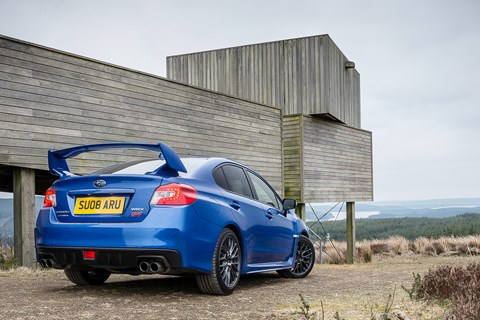
The interior didn’t bother me too much. It’s pretty practical to live with – the four doors, the interior legroom, the deep boot hiding under that huge rear wing. The quality of the interior isn’t a patch on, say, a modern Audi; and the red graphics are a bit 1990s; but I’ve lived with Subaru interiors for about 20 years now (I’ve owned three Foresters), so I guess I’m used to the hardwearing plastics and the no-nonsense design. Only the awful, aftermarket Alpine sat-nav and stereo system lets it down – Subaru needs to do a deal with its partner Toyota ASAP, and import some modern interior tech. This stuff makes the WRX feel more dated than the throwback World Rally styling.
Overall then, the WRX is a compromise – you get the occasional amazing drive and loads of charisma, but with a daily downside in terms of refinement and comfort. But the biggest blow to its appeal doesn’t lie in that trade-off, but in what the competition has to offer. Not long ago, the Subaru’s 296bhp power output would have been enough to set it above the hot-hatch crowd, but now the VW Golf R matches it in its all-wheel drive and power; and the new Ford Focus RS also has 4x4 and a whopping 350bhp. Both are just as fast and exciting as the Subaru; both are as practical; and frankly both are easier to live with, when you’re stuck in traffic on the way to the DIY shop on a Saturday morning.
So I loved our Subaru WRX long termer – occasionally – but not often enough. The litmus test for me is always, ‘Would I recommend this?’ And the answer to that is, sadly, no. If you have £30k and you’re looking for a practical family car that can also give you some thrills on a late-night drive home, choose the Focus RS.
Count the cost
Cost new £28,995 (including £0 of options)
Dealer sale price £28,002
Private sale price £26,692
Part-exchange price £25,452
Cost per mile 16p
Cost per mile including depreciation 63p
Logbook: Subaru WRX STI
Engine 2457cc 4-cyl boxer turbo, 296bhp @ 6000rpm, 300lb ft @ 4000rpm
Gearbox 6-speed manual, four-wheel drive
Stats 5.2sec 0-62mph, 159mph, 242g/km
Price £28,995
As tested £28,995
Miles this month 680
Total miles 7651
Our mpg 20.8
Official mpg 27.2
Fuel cost overall £1265.55
Extra costs £0
By Mark Walton
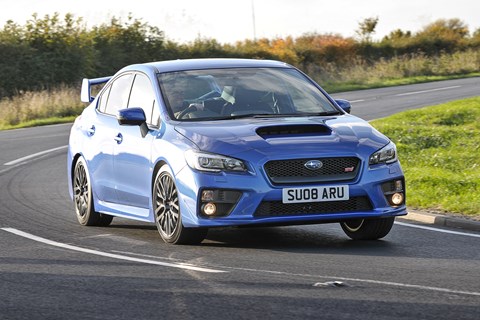
Month 7 running a 2016 Subaru WRX STI: the highs and lows, before it goes
The end is drawing near for our time with the Subaru, but one thing still stands out. If you’re driving in the wet there are few cars that can touch the WRX for cross-country pace.
The confidence with which it puts down its near-300bhp means you can thrash it in conditions that’ll leave most supercars tentatively looking for traction – not because of outright pace, but because the WRX driver feels supreme.
One wet drive is enough to rekindle my love for this car; a motorway journey is enough to make me hate it. It’s complex.
Logbook Subaru WRX STI
Engine 2457cc turbo 4-cyl, 296bhp @ 6000rpm, 300lb ft @ 4000rpm
Transmission 6-spd manual, awd
Stats 5.2sec 0-62mph, 159mph, 242g/km
Price £28,995
As tested £28,995
Miles this month 658
Total miles 6971
Our mpg 20.8
Official mpg 27.2
Fuel £140
Extra costs £0
By Mark Walton
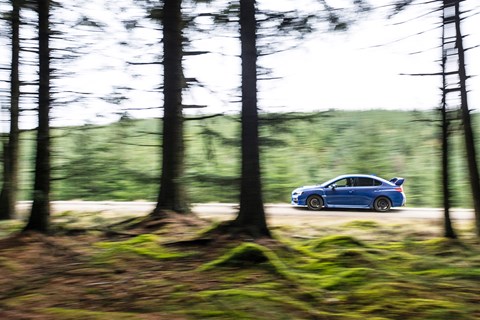
Month 6 running a 2016 Subaru WRX STI: a pilgrimage to Kielder
I think it got its nickname, ‘Killer’ Kielder, because no-one could think of any other words that began with K. In truth, this most famous of all British rally stages was more like ‘Krashy’ Kielder; maybe ‘Kwick’ Kielder. Very often ‘Extremely Kold’ Kielder. But ‘Killer’ was the name that stuck.
And it was a giant killer, in its day: ever since it first appeared as a special stage on the RAC Rally in 1961, it was a daunting and unpredictable place, even for the best drivers in the world. Back in the 1960s and early ’70s, when the British event was in its golden age, the RAC would travel the whole of the UK.
Hard to imagine it now: over the course of four or five days the rally would run for 2500 miles, starting in London (or Bournemouth!); driving up through Wales, stopping off at Oulton Park for a few laps before heading to the Lake District and Scotland. Then the cars would return (through Kielder) to East Anglia; a few laps of Snetterton, then back to London. Epic. And if you were to ask any of those drivers which section they feared most, out of the 80-odd special stages, they would probably say ‘Kielder’.
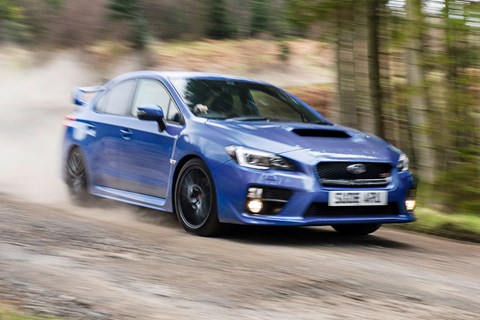
Made up of fast, undulating tracks of loose gravel with unforgiving ditches and trees, the drivers would find themselves in this godforsaken forest, with no pace notes, in November, often at night. Located an hour north-east of Carlisle, hugging the Scottish borders, Kielder Forest was a remote, unwelcoming, almost Gothic place: dark, foggy, and lacquered with black ice. (Unfortunately, not one of these words start with a K.)
Did I say the ’70s were the golden era? Maybe it was the 1980s, when Toivonen won the Group B Lancia Delta S4’s debut event? Or how about 1995, when McRae and Sainz went into the RAC neck-and-neck in the title race, flat-out in their blue-and-gold Imprezas. McRae was outrageously quick, but on Kielder’s Pundershaw stage – at 36 miles, the longest in the whole FIA World Championship – he smacked a rock and bent his suspension while ‘ditch hooking’. He and co-driver Derek Ringer straightened out the strut using a log (I mean, how do you even do that?) and limped on to the service park in Penrith. From there they won the rally, and the 1995 Championship.
Such are Kielder’s legends and stories; but the last time the forest actually appeared in the RAC/Network Q/(whatever it was called) was in 1996. The following year, the rally’s epicentre moved to Cheltenham and then Cardiff – what was once a UK-wide event with hundreds of thousands of spectators became ‘Wales Rally GB’: three days in a lorry park outside Swansea, only 20 special stages, many of them the same road run twice. This is vanilla rallying, bland and corporatised, and no-one even bothers with nicknames any more (except perhaps ‘Krap’).
So fast forward 20 years, and I’m driving CAR’s long-term-test Subaru WRX up to Kielder. Like the Rally GB, this iconic Subaru has changed a lot over the last two decades, and I can’t help feeling it – like the event – has somewhat lost its way. A late 1990s Subaru was, and still is, a pert, well-proportioned, surprisingly unadorned car (except for those magnificent gold wheels). It was fast enough, brutish enough, yet also poised and balanced.
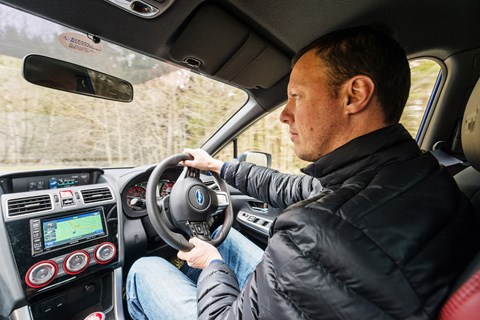
Having lived with the new WRX STI for a few months, I get tired of its hard ride, its jerky clutch and its ridiculous rear wing. It seems to be screaming ‘RALLY CAR’, yet it doesn’t quite go ‘The Full McRae’, as though Subaru’s a bit embarrassed by all that now. The Type UK comes with dark grey alloys as standard, but you can order gold wheels as a dealer option. When I call Subaru and suggest we might fit them, the answer comes back, ‘Are you being ironic?’ To which I replied, ‘Er, no, I actually like gold wheels’. I know I’ve bemoaned the Subaru model range before, but look at the XV, the Outback, the Levorg; not a hint of WRC glory. This is a brand determined to move on from those halcyon days, yet it doesn’t know what it wants to be instead.
Kielder never had that problem. When the rally spotlight moved south the forest reinvented itself as a wilderness for sailing and cycling. Taking advantage of its back-of-beyond location and zero light pollution, it built a small wooden observatory too, perched on a hill, for stargazing and educational events. Then in 2013 the International Dark Skies Association (yes, it’s a thing) granted Kielder ‘Gold Tier Dark Sky’ status, making it officially the biggest blackout zone in Europe. When we arrive and check into The Pheasant Inn, I get chatting to the chef. ‘Tourism used to be very seasonal here,’ he says. ‘We used to sit and try to think of ways of drumming up business in the winter – never thought anything of the stars outside. Then, from out of nowhere, they grant us this ‘Dark Sky’ status, and now we’re busy all year round!’
We drive north along the reservoir, and then jiggle up a bumpy track to the observatory. Built in 2008, it’s a striking, geometric building. Looking down over the forest as the light fades, it’s incredible to think that all this is planted by hand. It started after World War I, when the government created the Forestry Commission. The planting increased in the 1930s, when it provided jobs for the local unemployed miners. The result is the biggest manmade forest in Europe, covering about 250 square miles.
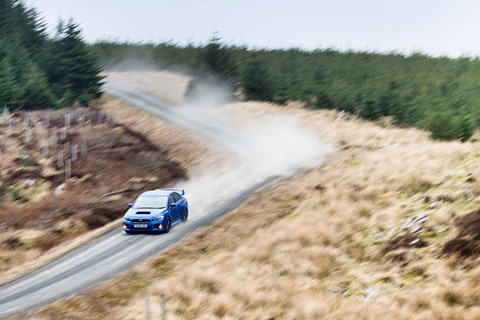
Next morning we explore (with permission) some of the Forestry Commission gravel tracks that weave through the forest. It’s surprising, after getting that bird’s-eye view, how open it seems down at ground level, where we find stretches of meadow and wide vistas. Since 1995, Kielder has been turning itself into an enormous sculpture park, and we come across strange architectural artworks in the trees. I was expecting it to feel dense and gloomy here, like a grainy 1980s rally DVD showing dark forest and sleet; instead, it feels like the modern, managed parkland it is.
The forest is riddled with gravel tracks. We’re not here to drive like McRae, but you can feel the WRX respond when you ask more of it – short, sharp punches of turbo acceleration, jabbing at the throttle and brake, the STI comes alive when you drive more purposefully, more intensely. It feels as if it still hankers after gold wheels too.
Most tracks are gated, but anyone can enjoy a bit of the old RAC Kielder by taking to Forest Drive, a rare, unsealed public road that heads north east out of Kielder village towards the A68. About 12 miles long, it’s one of Britain’s highest roads, cresting at about 1500 feet. Driving up here to this isolated spot, and imagining what it would be like to be here in the dark and the snow waiting for the Group B cars to come through flat-out, spitting fire, is a reminder that rallying was so popular then because it felt dangerous, like an adventure.
They’ve sterilised the sport, killing off ‘Killer Kielder’, running cars that feel like they belong in a junior series – it feels like they’re strangling the life out of it. And likewise Subaru – will this WRX, an aberration in the range, survive? Looking at the rest of the line-up, I can imagine it no longer fitting into any model plan. I hope, as pair of star-crossed brands, both Subaru and the WRC rediscover their mojos soon. I recommend their bosses take a joint trip to Kielder, and remember what that golden era was all about.
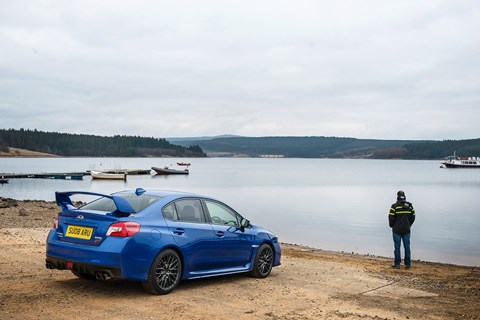
From the driving seat
+ Its rally heritage is still in there
– Noisy on a motorway
+ Absorbing drive when you focus on it
– Drive it like it wants to be driven and watch the mpg tumble
+ Four-door practicality for a longer journey
Logbook Subaru WRX STI
Engine 2457cc 4-cyl boxer turbo, 296bhp @ 6000rpm, 300lb ft @ 4000rpm
Transmission 6-speed manual, four-wheel drive
Stats 5.2sec 0-62mph, 159mph, 242g/km
Price £28,995
As tested £28,995
Miles this month 438
Total miles 6751
Our mpg 20.8
Official mpg 27.2
Fuel this month £112
Extra costs £0
Toivonen the legend, 30 years on
This year marks the 30th anniversary of the end of Group B. While I might want modern rallying to ‘man up’, no-one would want to return to 1986, but it’s sad the death of Henri Toivonen and his co-driver Sergio Cresta in Corsica overshadows one of the best rallies in history, the 1986 Monte Carlo.
In the new, mid-engined 500bhp Delta S4, the young Toivonen looked favourite to win the title. He was leading the Monte when he hit a spectator’s car and was bruised so badly he was on painkillers for the rest of the rally. What followed was one of the greatest drives ever seen: coming from a minute down he drove like an inspired genius, the kind of drive we remember McRae for. He won, and it looked like his destiny was set.
By Mark Walton
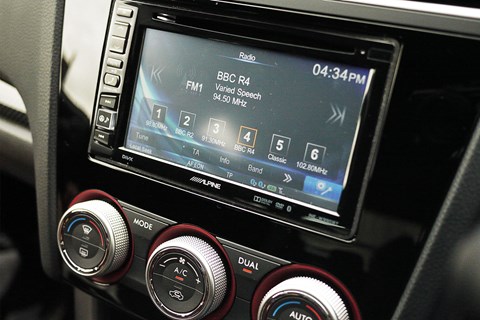
Month 5 running a 2016 Subaru WRX STI: it ain't all bad, on the inside
When car folk talk to me about the Subaru many of them ask about the performance first and the interior second. Subaru has a reputation for bad plastics and cheap detailing, but I don’t find the WRX that offensive – it’s not up to German standards, but it’s no worse than your average Japanese standards either.
What lets it down is the Alpine sat-nav and sound system: yes it’s a colour screen, but it’s fiddly to use and it looks so aftermarket. It suggests trips to Halfords, massive exhausts, and auxiliary boost gauges fitted to the top of the dashboard.
Logbook: Subaru WRX STI
Price £28,995
As tested £28,995
Miles this month 1316
Total miles 6313
Our mpg 20.8
Official mpg 27.2
Fuel this month £280.32
Extra costs £0
By Mark Walton
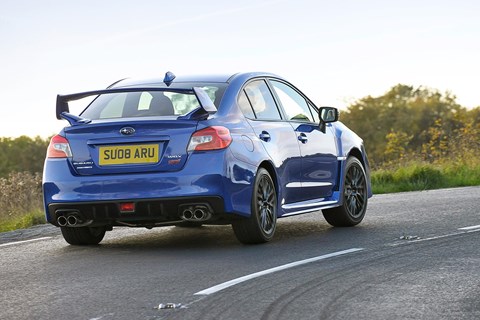
Month 4 running a 2016 Subaru WRX STI: unscheduled hare appointment
Somewhere out there, there’s a rabbit wearing part of my Subaru as a hat. Well, when I say rabbit, I mean a giant hare of the ‘mad March’ variety, about as big as a greyhound dog. The hare in question ran out in front of me and collided with the STI’s nose (a polite way of saying I ran over it). I was on a dual carriageway so I couldn’t stop immediately, but I knew there’d be damage – it sounded like I’d hit a rock. Yuck. When I eventually pulled over, I was expecting to find gore, but apart from a bit of brown fluff there was no sign of the poor animal. Mysteriously, there was also no sign of an entire black plastic shroud around the driver’s side fog light. It was as though the hare had time – during the collision – to get a screwdriver out and carefully prize it off. Anyway, I need to get it fixed – I’ll report back next month.
In the meantime, I thought I’d share my thoughts on the Subaru as a family car. One of the advantages of the original Impreza Turbo that’s still true today is that it’s based on a practical four-door saloon. Some might sneer at its humble origins, but it does make the car easier to live with than, say, its BRZ coupe cousin.
One of the things that surprised me was the size of the STI’s boot. Okay, so my younger daughter is only three, but even so her bike is easily chucked into the cavernous space beneath the blue spoiler, with room to put her in there too, if I wanted. (I don’t actually do that. Just to be clear. I’m just saying I could.) For drivers who need to justify buying their STI on the basis it’ll also double up as the family workhorse, this big boot is your ace card.
As an aside, it’s a shame Subaru doesn’t still make the old Impreza Sport Wagon – remember the short-tail-estate hatchback version of the Impreza? These days the ‘Impreza’ estate is called the Levorg, but it’s longer than the old Sport Wagon (more like a Legacy Outback) and like the WRX it’s only sold in the UK as a single-spec car – unfortunately, a 1.6 turbo with a ‘Lineartronic’ CVT transmission. Ew.
Anyway, all the points our STI long-termer scores as a practical four-door it then loses because of the ride. To be honest, my family’s not dead keen to go on a shopping trip in it, because at lower speeds, when you’re pootling in town, the ride is irritating – I mean, it’s head-wobblingly jiggly, and if you have to do a couple of hill-starts in traffic, the clutch will immediately start stinking like you’ve set fire to some plastic in the footwell.
So our mixed feelings about the STI continue. As always, it’s best when you’re driving flat-out on your own, preferably in the wet. It’s practical yes, but in its heart it’s still a rally car more than a family car.
By Mark Walton
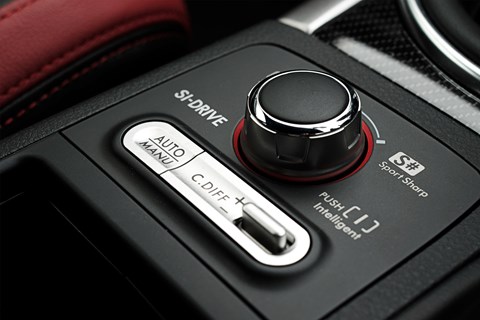
Month 3 running a 2016 Subaru WRX STI: never mind the dampers, feel the diff
I love driving the Subaru fast, but at lower speeds around town the ride is painfully stiff. If it had adaptable suspension, it’s like it’s permanently set in Race mode. Unfortunately, it isn’t adjustable, so we’re stuck with hard dampers even on a pot-holed high street. Passengers jiggle up and down like unwilling parents on a bouncy castle.
However, in true nerdy, technical Subaru style, the centre differential is adjustable. Perfect for… er, actually I’m not sure why they made the diff adjustable. Unless (like me), you want to get it sideways at every opportunity.
Drive the WRX hard and keep the diff in Auto mode, and the handling’s pretty neutral, with a bit of understeer in the wet. It’s not painfully intrusive though, and overall you can keep up a wicked pace. I often take the longer route home from work, down an empty, twisting back road. I’m always astonished at how you can maintain momentum, cross-country, even in a downpour.
However, fiddle with the ‘Driver’s Control Centre Differential’ (or DCCD) and you can manually fix the torque distribution between the front and rear axles. Subaru explains that adjusting rearward ‘sharpens cornering’ and forward ‘increases traction’; what they’re really talking about is oversteer. In my case I only adjust one way, all the way to the back.
There’s also a knob for engaging the ‘Sport Sharp’ setting, which remaps the engine to give you a hair-trigger throttle and a turbo boost so sudden it makes you yelp. Channelling torque rearward in this mode, with traction control off, the car is markedly less well balanced, and choosing steering angles feels less instinctive. But on my favourite curly off-ramp, or accelerating out of a junction in the wet, you can get the Subaru to slide like Solberg, which makes me grin like a Cheshire cat.
Unfortunately, fuel economy is heading south with all this playing around. Over the month I’m down to 20mpg, but I know on some journeys it’s probably been 17 or 18mpg. The boxer engine is a beaut, but there’s a price to pay for everything in life, including tail-slides.
From the driving seat:
+ Purposeful driving position and great seats
+ Supercar pace cross country
+ Every last drop of the 300bhp is exploitable
– Suspension is jerky-bouncy stiff round town
– My wallet is wilting with the fuel consumption
By Mark Walton
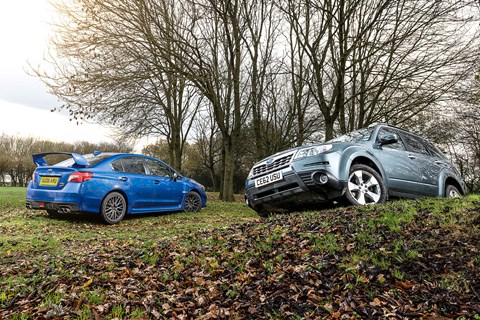
Month 2 running a 2016 Subaru WRX STI: keeping it in the family
If you felt last month’s intro to our new WRX was unfair to Subaru (‘a tide of anonymous hatchback and bizarre estates’) don’t worry, I’m allowed to be rude, I’m an actual Subaru owner.
This diesel Forester is our family workhorse, purchased with my own money (that’s like a cat burglar buying his own ladder). The common genes? They share the same firmly sprung solidity, 4x4 grip and innate balance; but deep down, I just love the brand – the ‘Fuji Heavy Industries’ badge and the quirky engineering. Any criticism is just me being cruel to be kind.
By Mark Walton

Month 1 running a 2016 Subaru WRX STI: the introduction to our long-term test
The first time I drove our new Subaru, I filled up with petrol and as I walked into the shop a guy at the cash machine shouted ‘Nice car mate!’. When I came out three minutes later he was standing by the car, staring at it with his young son. ‘I’ve had a few of these,’ he said in hushed admiration. He went on to tell me his entire Subaru history.
Welcome to the WRX Club: membership is automatic upon purchase, and the entry fee is £28,995. Since that first night it’s happened a lot, and I realise now I’m part of a cult. While a Lamborghini or Ferrari attracts people who want to take selfies, and a classic car is an invitation to ask questions, the Subaru is a honeypot to a very specific type of enthusiast, of a specific age, who wants to have a specific conversation.
Knowledgable, passionate and clearly with plenty of disposable income, these are the guys (they’re all men) who have kept the Subaru brand alive in the UK, despite a range that’s become – let’s be honest – a bit ‘patchy’ in recent years.
Let’s browse the showroom, shall we? The Impreza lives on, but 20 years after McRae won his Championship and almost a decade since Subaru withdrew from the WRC in 2008, the Impreza is now a lame-looking 1.6 hatchback. Beside it there’s the increasingly ugly Forester; the Legacy-now-just-called-Outback; the bizarrely named ‘Levorg’; the hard-to-pin-down XV; and the BRZ coupe. Alongside this really random bunch of misfits is the WRX, the most reassuringly familiar car of the whole lot; but even here, Subaru messes with your mind by not calling it ‘an Impreza’ – it’s just called ‘WRX STI’.
Talk about putting your brand through the mangler. I’m still amazed that when Subaru withdrew from rallying you could show someone a blue and gold blur and they would immediately know what car they were looking at. In terms of global recognition, Subaru owned a colour like Ferrari owns red. It was worth gazillions in brand recognition, and since then they’ve let it all wash away in a tide of anonymous hatchbacks and bizarre estates.
But that legacy hasn’t completely gone (not that Legacy – that’s called an Outback now). I ordered the WRX in blue, after all. I am a man of a certain age, and I am now part of a cult. I ordered blue, yes, and I would have ordered gold wheels too, if they’d been on the menu; but you soon discover, as you flick through the WRX brochure, this is a strictly single-model car, specced up in standard trim with barely any extras to choose from. The 18-inch gunmetal alloys; the rear wing; the leather and alcantara interior – all standard. The Alpine sat-nav and music system looks aftermarket, like it was fitted by Halfords, but that too is standard.
Overall then, it’s a bit bling, a bit boy racer, a bit of a blast from the past. But then you drive it on the road… My god, this thing is brutally quick. It may be ‘only’ 296bhp – in a world where cars such as the Ferrari 488 are producing over 600 – but in the real world… in the wet!… the Subaru can still produce the Shock and Awe. I’m looking forward to getting to know it better. I just hope I can hang on to my driving licence.
By Mark Walton
Click here to read CAR's Subaru WRX STi vs VW Golf R comparison test